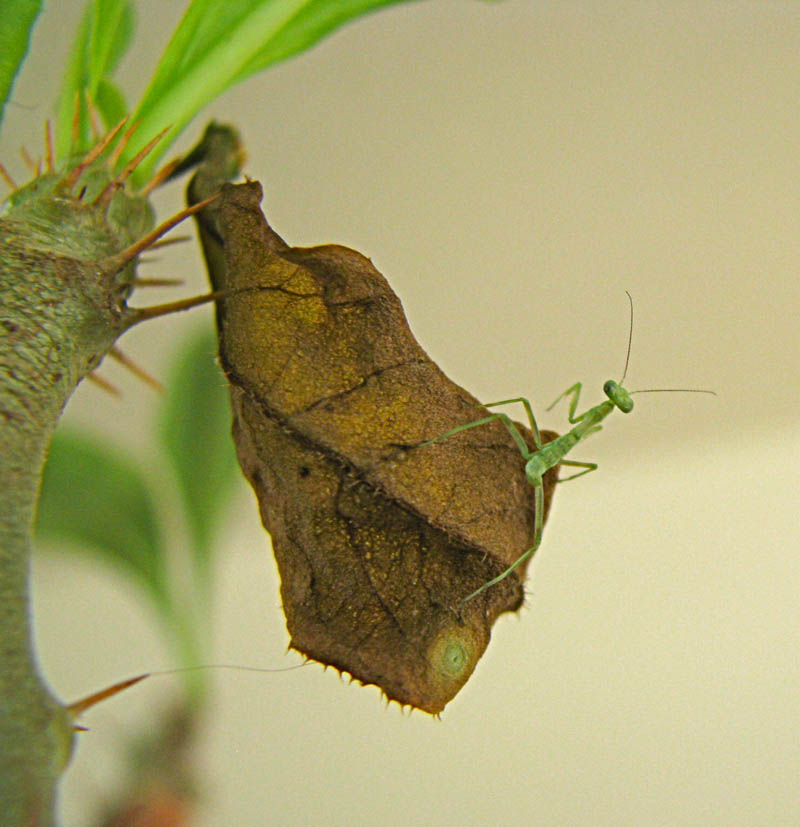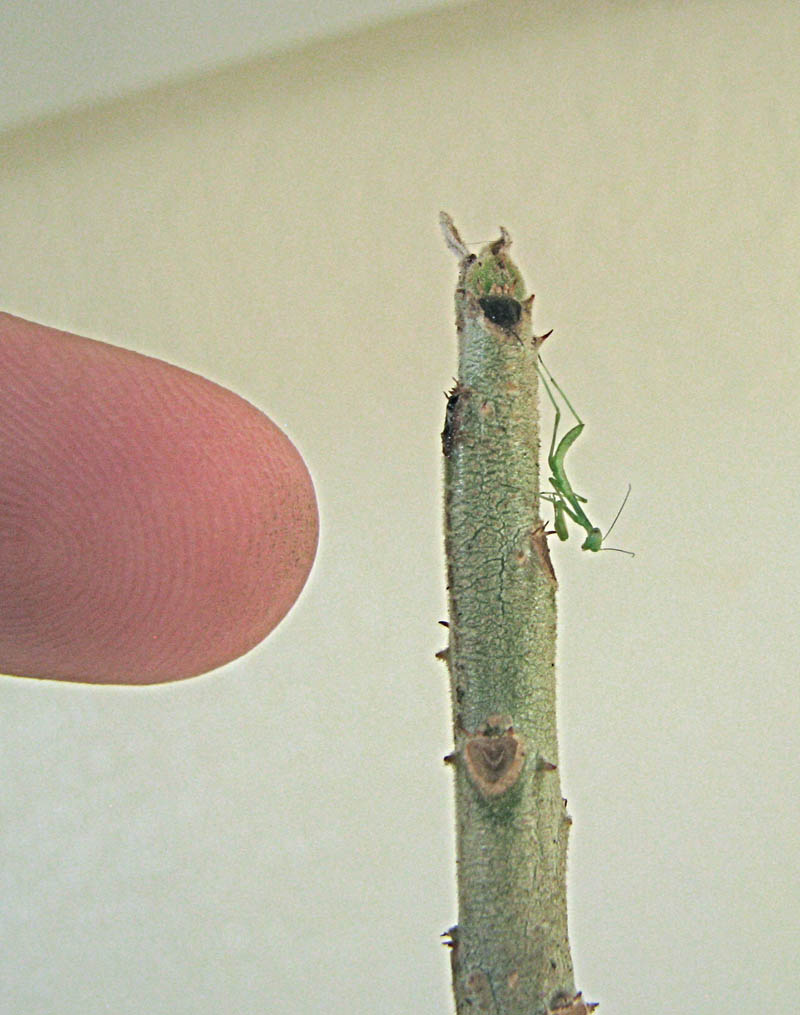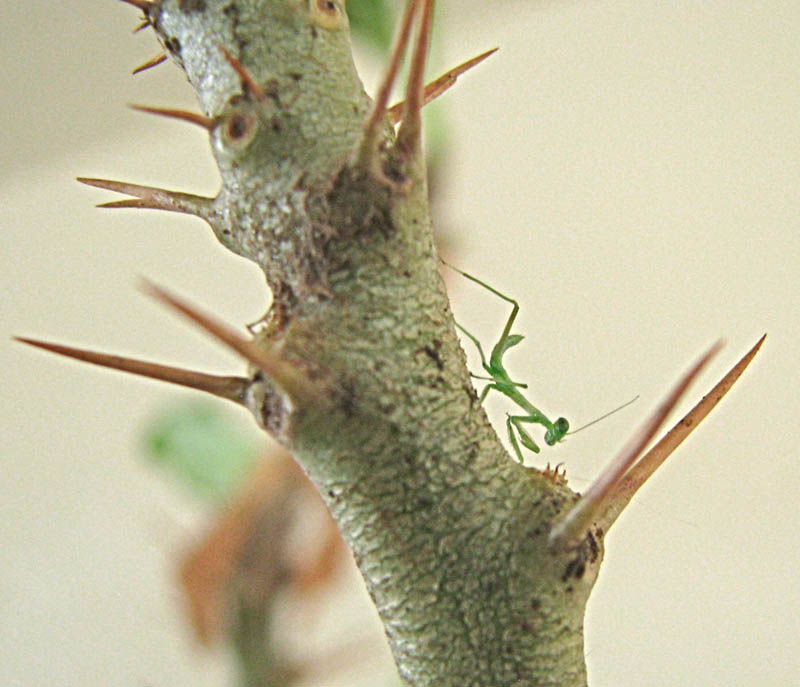Lil mantids, or: imagine our surprise
We grow succulents at our house in containers, and some of them can’t take the heat of the low desert summers, while others can’t take the hardest frosts of winter. This results in a constant migration of plants inward and outward between the house and yard, depending on the season. The indoor space the plants inhabit is a set of wall-shelves  perched in a loft area above the bed. Every once in a while the cats get up there – in the avatar of furry negative forces of destruction and sudden catastrophe – and implement their conviction that one or the other potted plant would be better on the carpet, which results in a loud thump, crushed foliage, and a shower of dirt and gravel onto us in the middle of the night, causing much heart-pounding and swearing.
perched in a loft area above the bed. Every once in a while the cats get up there – in the avatar of furry negative forces of destruction and sudden catastrophe – and implement their conviction that one or the other potted plant would be better on the carpet, which results in a loud thump, crushed foliage, and a shower of dirt and gravel onto us in the middle of the night, causing much heart-pounding and swearing.
The other result of having the indoor-outdoor shift in place is that things get imported into the bedroom that really would be better off outside. Last fall, unbeknownst to us, one of the plants that came in for the cold season was an Adenium where a Praying mantis had secreted her breadloaf-brown egg case.  The first we knew about it was when E went up the spiral staircase to water plants, and found, pinnacled on the tip of a succulent, the tiniest possible baby green mantis – looking just like a big one, but not as big as a human fingertip. A quick search around yielded a dozen more, freshly hatched, as well as the egg-case itself on a nearby plant.
The first we knew about it was when E went up the spiral staircase to water plants, and found, pinnacled on the tip of a succulent, the tiniest possible baby green mantis – looking just like a big one, but not as big as a human fingertip. A quick search around yielded a dozen more, freshly hatched, as well as the egg-case itself on a nearby plant.
We instantly whisked the nest-plant outside, before the fur-bearers discovered the movable feast of lively greenlings, and where they could disseminate into the garden and find plenty of food to eat, unlike the largely tiny-prey free desert of the bedroom. We’ve had young mantises around before and they are very voracious younglings, eating anything that moves which they are strong enough to grasp and render immobile. This is the other function of allowing them to wander off, each in a different direction — they will eat each other, if hungry enough.
By next morning, all but one of them had made its way away from the eggcase Adenium, except for one guy who figured he was okay where he was. With luck they will mature into one of the mantids native to the Sonoran desert. Or, they may grow into an imported mantid from the Mediterranean or China that people release to control garden pests. Of course, many may be eaten by birds or raccoons, but even that way, they’re in the natural system, and out of the bedroom. Bonne chance, tiny predators!
them had made its way away from the eggcase Adenium, except for one guy who figured he was okay where he was. With luck they will mature into one of the mantids native to the Sonoran desert. Or, they may grow into an imported mantid from the Mediterranean or China that people release to control garden pests. Of course, many may be eaten by birds or raccoons, but even that way, they’re in the natural system, and out of the bedroom. Bonne chance, tiny predators!
(all photos by E. Shock)

[…] was our second mantis-related sighting of the week — the other is described here, in the latest post on this […]
[…] of everything. I feel it when seeing tiny cottontails hidden out in the open in their form, hatchling praying mantids swarming out of their bread-loaf egg-case, nest-cached hummingbirds waiting for mother to dispense […]
[…] Last night, we had a small native desert praying mantis on the screen door, swivelling its big-eye head in the dim light. In real life these aren’t blue, of course (that’s just photo-artsiness to distract from the low-light graininess in my shot) — or green like the giant asian species people buy online to release for garden pest control. These little ones are grayish brown, and this one is full grown at under two inches. These are the guys whose breadloaf-like eggcases we find in the yard (or, once, in the house on a plant we took in for the winter; the hatchling mantids are green). […]